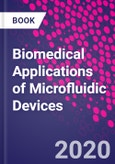Biomedical Applications of Microfluidic Devices introduces the subject of microfluidics and covers the basic principles of design and synthesis of actual microchannels. The book then explores how the devices are coupled to signal read-outs and calibrated, including applications of microfluidics in areas such as tissue engineering, organ-on-a-chip devices, pathogen identification, and drug/gene delivery. This book covers high-impact fields (microarrays, organ-on-a-chip, pathogen detection, cancer research, drug delivery systems, gene delivery, and tissue engineering) and shows how microfluidics is playing a key role in these areas, which are big drivers in biomedical engineering research.
This book addresses the fundamental concepts and fabrication methods of microfluidic systems for those who want to start working in the area or who want to learn about the latest advances being made. The subjects covered are also an asset to companies working in this field that need to understand the current state-of-the-art. The book is ideal for courses on microfluidics, biosensors, drug targeting, and BioMEMs, and as a reference for PhD students. The book covers the emerging and most promising areas of biomedical applications of microfluidic devices in a single place and offers a vision of the future.
Please Note: This is an On Demand product, delivery may take up to 11 working days after payment has been received.
Table of Contents
1. Microfluidic devices: Concepts 2. Microfludic devices: Synthesis approaches 3. Design of microchannels in microfluidic devices 4. Microarray technologies 5. Organ-on-a-chip devices 6. Microfluidic devices for pathogen detection 7. Microfluidic devices for detection of cancer cells 8. Microfluidic devices for drug delivery systems 9. Microfluidic devices for gene delivery systems 10. Microfluidic devices for tissue engineering 11. Microfludics in organic chemistry 12. Microfludics in inorganic chemistry 13. Paper based microfluidic devices 14. Smart phone based microfluidic devices 15. Microfluidics: Future perspectives








